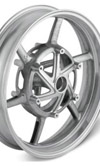Next generation passivation treatments
 Non-electrolytic passivation (often referred to as conversion coating) is one of the most common treatments for aluminum surfaces that need to be made corrosion resistant, while still remaining conductive electrically. Because of its ease of processing, it is one of the lowest cost anticorrosion preparations available.Chromate conversions (‘Iridite’ and ‘Alodine’) have been the traditional passivation application for aluminum alloys, both wrought and cast.
Non-electrolytic passivation (often referred to as conversion coating) is one of the most common treatments for aluminum surfaces that need to be made corrosion resistant, while still remaining conductive electrically. Because of its ease of processing, it is one of the lowest cost anticorrosion preparations available.Chromate conversions (‘Iridite’ and ‘Alodine’) have been the traditional passivation application for aluminum alloys, both wrought and cast.
The treatment is normally distinguishable by the gold-yellow appearance that is typically imparted to aluminum components, and used almost universally on electronic parts, as well as military and aerospace housings and structural applications. Conversion coating is often specified as the substrate for subsequent painting and coating operations, since it acts much like a primer, and improves adhesion to aluminum surfaces greatly. Finally, for applications such as gearboxes, the improvement in emissivity over the bare aluminum may even allow for slightly cooler operating temperatures.In motorsport applications, wrought materials are usually anodized, but in particular, aluminium drivetrain castings frequently are not, and their surfaces are left as cast. This is particularly true of competition at club level, where individual engine builders may view any coating process as an inconvenient waste of time. However, it is the engines at this level that frequently are not even rebuilt once a year (and sometimes not even that often), and if the competition occurs in rally or marine venues, where water, in some cases saltwater, is frequently encountered, the inexpensive protection from a passivation bath should be doubly welcome. The widespread availability, fast cycle time, and again, low cost, make this an easy option.
The emerging problem is that the common and traditional chromate conversions are not compliant with RoHS and ELV directives. In particular, the hexavalent chromium component present in this material is especially offensive in this respect. It is clear that these treatments will be progressively phased out over time.In the last couple of years, however, new passivation treatments for aluminum have been developed. These are now available through many plating firms, and are said to have significant advantages. The new conversion coatings are not affected by baking as with chromate-based passivation, and no curing or ageing is needed prior to painting or coating. The manufacturers of the non-chromate treatment claim that it performs just as well as traditional conversion coatings, and that it meets the requirements of MIL-C-5541 electrical conductivity, and in ASTM B 117 testing its corrosion resistance has been shown to be comparable to chromate conversion. A wide range of concentration percentages, temperatures, and immersion times can be tailored to a user’s specific needs. Most manufacturers also offer a ‘paint brush’ type repair kit for scratches or other injuries to the treated surface.Conversion coatings are typically applied in a four-step process: initial wash, etch, passivation dip, and rinse, which can be accomplished in four moderate-sized polypropylene tanks. The elimination of the chromium materials makes prototype and low-use ‘convenience’ setups viable for individual companies as the removal of hazardous waste is greatly simplified, with much lower costs. Local environmental and waste officials should be contacted regarding these considerations before setting up a passivation station in-house.